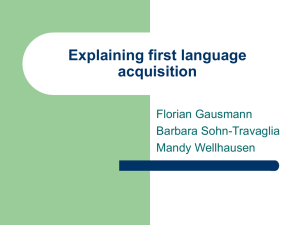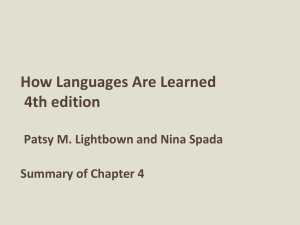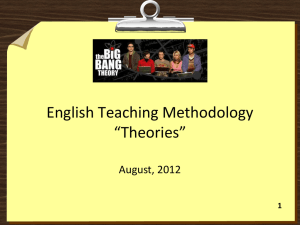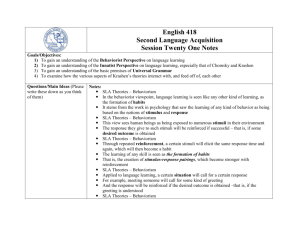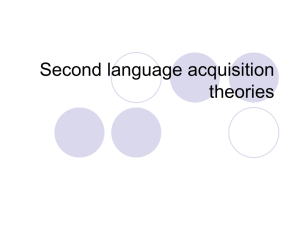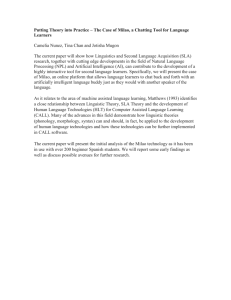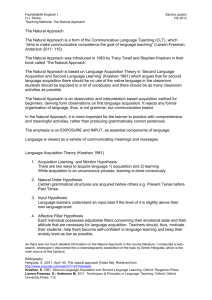English 507 Writing in a Second Language Session Six Notes Goals
advertisement
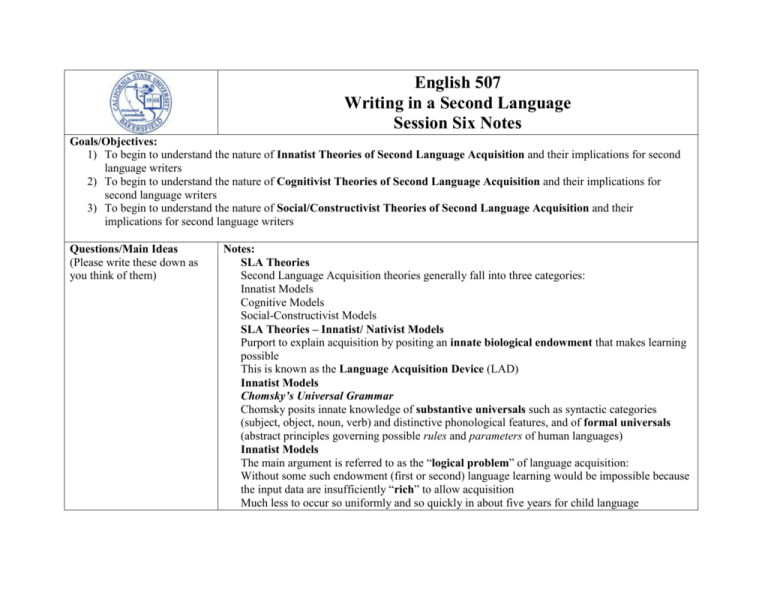
English 507 Writing in a Second Language Session Six Notes Goals/Objectives: 1) To begin to understand the nature of Innatist Theories of Second Language Acquisition and their implications for second language writers 2) To begin to understand the nature of Cognitivist Theories of Second Language Acquisition and their implications for second language writers 3) To begin to understand the nature of Social/Constructivist Theories of Second Language Acquisition and their implications for second language writers Questions/Main Ideas (Please write these down as you think of them) Notes: SLA Theories Second Language Acquisition theories generally fall into three categories: Innatist Models Cognitive Models Social-Constructivist Models SLA Theories – Innatist/ Nativist Models Purport to explain acquisition by positing an innate biological endowment that makes learning possible This is known as the Language Acquisition Device (LAD) Innatist Models Chomsky’s Universal Grammar Chomsky posits innate knowledge of substantive universals such as syntactic categories (subject, object, noun, verb) and distinctive phonological features, and of formal universals (abstract principles governing possible rules and parameters of human languages) Innatist Models The main argument is referred to as the “logical problem” of language acquisition: Without some such endowment (first or second) language learning would be impossible because the input data are insufficiently “rich” to allow acquisition Much less to occur so uniformly and so quickly in about five years for child language Innatist Models According to the Chomskyan perspective, the input is deficient, or “poor”, in two ways: First, it is claimed to be degenerate in the sense that it is marred by performance features Examples include: false starts, slips, fragments, and ungrammaticality Innatist Models Therefore, so the argument goes, it is an inadequate base for language learning Second, and more serious, the input is “degenerate” in various ways Most importantly, it does not contain “negative evidence”: Innatist Models Information from which the learner could work out what is not possible in a given language Overt negative evidence is unavailable because caregivers react to the truth value, not the form, of children’s utterances and rarely correct ungrammatical speech Innatist Models Covert negative evidence is also unavailable, since, even if they hear ungrammatical sentences, they have no way to know which ones are acceptable and which ones unacceptable Hence, the grammars that learners in fact evolve are said to be “underdetermined” by the input Called “poverty of the stimulus” Innatist Models UG assumes that language consists of a set of principles (abstract rules) that characterize core grammars of all natural languages However, in addition to principles that are invariable across natural languages, are parameters that vary across languages Innatist Models Cook helps explain: Overall there is a principle that drivers have to keep consistently to one side of the road, which is taken for granted by all drivers in all countries. Exceptions to this principle, such as people driving down motorways on the wrong side, rate stories in the media or car chases in action movies. The principle does not, however, say which side of the road people should drive on (the parameter) Innatist Models A parameter of driving allows the side to be the left side in England and Japan, and the right side in the USA and France The parameter has two values or “settings” – left and right Once a country has opted for one side or the other, it sticks to its choice Innatist Models So, a universal principle and a variable parameter together sum up the essence of driving The principle states the universal requirement on driving: You must choose one side of the road or the other The parameter specifies the variation between countries Innatist Models How does it work in language learning? If children have to learn a complex set of abstractions, there must be something other than the language input to which they are exposed that enables them to learn language with relative ease and speed UG is postulated as an innate language facility that limits the extent to which languages can vary Innatist Models That is, it specifies the limits of a possible language The mental task for learning is therefore greatly reduced if one is equipped with an innate mechanism that constrains possible grammar formation Question? If we take the Chomskyan perspective to be true, what are the implications for teaching ESL writing? Of the “poverty of the stimulus”? Of the limitations on language? Innatist Models Krashen’s Monitor Model/Monitor Theory One of the best known and most influential Innatist theories in SLA (through the 1970s and 1980s) is Krashen’s Monitor Model Innatist Models In its earliest incarnation, it was an attempt to reconcile two phenomena: First, a generalization from morpheme studies that there existed a statistically significant association between the orders of appearance of certain English grammatical morphemes, accurately supplied in obligatory contexts, in the speech and writing of SL learners of different ages, L1 backgrounds, and conditions Innatist Models Second, disturbances were observed in this “natural order” on certain performance tasks, specifically the reading and writing tasks, as compared to three other listening and speaking tasks Krashen explained this difference by claiming that two separate knowledge systems underlay SL performance Innatist Models The first, and most important, the acquired system, was the product of application by learners of the same (unspecified) language learning abilities children use for first language acquisition Consisted of subconscious knowledge of the SL grammar, like the subconscious knowledge NSs have of their first language Innatist Models The second, (and less important to Krashen), the learned system, was the product of formal instruction (typically classroom language teaching) and comprised conscious knowledge of “easy” SL grammar rules, like subject-verb agreement Innatist Models According to Krashen, the acquired system was typically the only knowledge source speakers could use in real-time communication, when they were attending to meaning, not to form The learned system was only accessible when three conditions were met: Innatist Models 1. There was sufficient time (the task was unspeeded) 2. The learner was focused on form (like during a discrete point grammar test) 3. When the learner knows the rule Innatist Models The Natural Order was the surface manifestation of the acquired system Disturbances were caused by the intrusion of the learned system on performance tasks that encouraged its use (like writing or reading) Led to five major claims over a period of time (not all are as equally important): Innatist Models 1] The Acquisition-Learning Hypothesis: States that there are two independent ways of learning a SL: acquisition and learning Acquisition is subconscious (covert) Learning is conscious (overt) Innatist Models 2] The Natural Order Hypothesis: Says that SL rules are acquired in a predictable order, one apparently not determined solely by linguistic complexity, and certainly not in the order in which the items appear in teaching syllabuses IOW, acquisition orders do not reflect instructional sequences Innatist Models 3] The Monitor Hypothesis: Encapsulates a relationship between the acquired system and the learned system The acquired system is the utterance initiator, with the learned system acting in a planning, editing, and correcting function when the three conditions are met Innatist Models 4] The Input Hypothesis: attempts to explain how a learner acquires a SL (Krashen calls it the central claim of Monitor Theory) It maintains that a SL is acquired through processing comprehensible input, that is language that is heard or read and understood Language that is not understood does not help; if it is too advanced, it is just noise in the system Innatist Models If the input is too simple (that is, already learned), it won’t help either Processing along the “natural order” is achieved when a learner at some stage, “i”, of interlanguage development receives comprehensible input that contains structures (lexis, sounds, morphology, syntax, etc.) one step beyond the current stage, or structures at “i + 1” Innatist Models The unknown structure is understood (the necessary precursor for acquisition) through the help of linguistic and extra-linguistic context, knowledge of the world, previously acquired linguistic knowledge, and in a classroom, by means of pictures, translation, and explanation Innatist Models 5] The Affective Filter Hypothesis: various affective (emotional) factors, (motivation, selfefficacy, anxiety) play a facilitative, but non-causal role in SLA Lack of motivation, high anxiety, etc., can combine to “raise the filter” to form a “mental block” which prevents CI from reaching the LAD and thereby being used for acquisition Innatist Models A negative affective disposition (a filter that is “up”) constitutes a constraint on the successful workings of CI IOW, a positive affect is necessary, but not sufficient, for SLA To Krashen, comprehensible input is the essential ingredient for second-language acquisition Innatist Models Question? If we take Krashen’s perspective as being true, what are the implications for teaching second language writing? Of the learning vs. acquisition dichotomy? Of the input hypothesis? Of the affective filter? Cognitive Models The Perceptual Saliency Approach: Dan Slobin argues that the similarity in linguistic development across children and across language is due to the fact that human beings are programmed to perceive and organize information in certain ways Cognitive Models IOW, it is perceptual saliency which drives the learning process, rather than an innate language-specific module Something is salient if it is striking or conspicuous. Something is salient if it is noticeably important. Cognitive Models Perceptual saliency has then been used to look at SLA in terms of Learnability/Teachability This notion implies that structures only become ‘learnable’ when the previous steps on this inquisitional path have been acquired Cognitive Models IOW, learners cannot acquire a complex structure straight away, but have to follow the developmental route associated with this structure Question? What are the implications of this perspective on ESL writing? Cognitive Models McLaughlin’s Information Processing Model: 1. Humans are viewed as autonomous and active 2. The mind is a general-purpose, symbol-processing system 3. Complex behavior is composed of simpler processes Cognitive Models 4. Processes take time 5. The mind is a limited-capacity processor To learn a second language is to learn a skill, because various aspects of the task must be practiced and integrated into fluent performance This requires the automatization of component sub-skills Cognitive Models The way in which we process information may be either controlled or automatic Language learning involves a shift from controlled towards automatic processing Learners first resort to controlled processing in the L2 This involves the temporary activation of a selection of information nodes in the memory Cognitive Models Such processing requires a lot of attentional control on the part of the subject, and is constrained by the limitations of Short Term Memory (STM) Through repeated activation, sequences first produced by controlled processing become automatic Cognitive Models Automatized sequences are stored as units in the Long Term Memory (LTM), which means that they can be made available very rapidly whenever the situation requires it, with minimal attentional control on the part of the subject As a result, automatic processes can work in parallel, activating clusters of complex cognitive skills simultaneously Cognitive Models Learning in this view is seen as the movement from controlled to automatic processing via repeated activation (practice) When this shift occurs, controlled processes are freed to deal with higher levels of processing (that is, to the integration of still more complex skill clusters), which explains the incremental nature of learning Cognitive Models It is necessary for simple sub-skills and routines to become automatic before more complex ones can be tackled Question? If we take this perspective to be true, what are the implications? Cognitive Models Anderson’s ACT Model (Adaptive Control of Thought) 1983; 1985 It enables declarative knowledge (knowledge that¸ not unlike controlled processes) to become procedural knowledge (knowledge how, not unlike automatic knowledge) Cognitive Models One of the major differences is that Anderson posits three kinds of memory: 1) a working memory (short-term memory) and two kinds of long term memory 2) a declarative LTM and 3) a procedural LTM There is a difference in knowing that and knowing how Cognitive Models Anderson states that the move from declarative to procedural knowledge takes place in three stages: 1) The cognitive stage: a description of the skill is learned (STM) 2) The associative stage: a method for performing the skill is worked out (DLTM) 3) The autonomous stage: the skill becomes more and more rapid and automatic (PLTM) Social Constructivist/ Interactionist Models Long’s Interaction Hypothesis: For his doctoral research, Long conducted a study of sixteen NS-NS and sixteen NS-NNS pairs Subjects carried out the same set of face-to-face oral tasks (informal conversation, giving instructions for games, playing the games, etc.) Interactionist Models He showed that there was little linguistic difference between the talk produced by NS-NS and NS-NNS pairs, as shown on several measures of grammatical complexity However, there were significant differences between the two sets of conversations, when these were analyzed from the point of view of conversational management and language functions performed Interactionist Models Specifically, in order to solve ongoing communication difficulties, the NS-NNS pairs were much more likely to make use of conversational tactics Repetition Comprehension checks Clarification requests Interactionist Models NS apparently resorting to these tactics in order to solve communication problems, not with any conscious motive to teach grammar The prime trigger for adjustment is the perception that the interlocutor is experiencing comprehension problems Interactionist Models Essentially an extension of Krashen’s hypothesis They work to ensure that the learner is receiving i + 1, rather that i + 3 or i + 0 Question? What are the implications for L2 writing of this perspective? Summary/Minute Paper:
